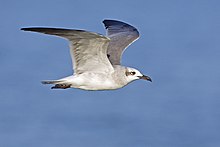

The gull wing, also known as Polish wing or Puławski wing, is an aircraft wing configuration with a prominent bend in the wing inner section towards the wing root. Its name is derived from the seabirds which it resembles and from the Polish aircraft designer Zygmunt Puławski who started using this design in his planes. Numerous aircraft have incorporated such wings for a diverse range of purposes. The gull wing was commonly used to improve visibility in a high wing arrangement, because such wing could be thinnest by the fuselage, and in theory should limit pilot's view no more than A-pillars of a windscreen in a car body.
Gliders were the first aircraft to feature the gull wing, starting with the Weltensegler in 1921; it was not until the record-breaking Fafnir at the end of that decade did the configuration gain popularity. Beyond becoming popular for the next three decades amongst high-performance gliders, various ground-based aircraft and flying boats also adopted various forms of gull wings. It rose to particular prominence in Poland, where the Polish aviation designer Zygmunt Puławski developed a range of fighter aircraft during the late 1920s and early 1930s; in particular, the PZL P.11, which possessed various cutting-edge features for the era in addition to its high-mounted gull wing, has been described as being the most advanced fighter aircraft of its kind in the world upon its introduction.[1] The PZL P.11 served as Poland's primary fighter aircraft during the mid to late 1930s, while its further development, the PZL P.24, served in the air forces of several countries and was a major success of the Polish aircraft industry.
Various flying boats, such as the Short Knuckleduster, Dornier Do 26, and PBM Mariner, also adopted the gull wing configuration, primarily as it enabled the engines to be positioned higher above the water. A variant of the standard configuration, the inverted gull wing, has been used on numerous fighters to facilitate the use of shorter landing gear and to provide sufficient ground clearance for their propellers. The most distinctive feature of the Junkers Ju 87 Stuka, a German ground attack aircraft used during the Second World War, is probably its inverted gull wing configuration.